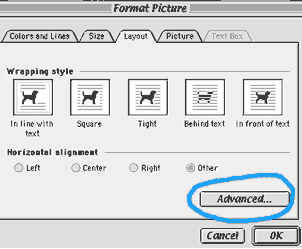Combining text and graphic files
Copyright Charley Weiland. Last revision January 7, 2002
There are several techniques for combining text and illustrations into one document, such as might be used for an NSF proposal or a dissertation. The easiest tool is Microsoft Word. There are professional page layout tools, like Quark Express, Adobe FrameMaker, Adobe InDesign and Adobe PageMaker, and others. These tools are used by the printing industry and as such may be expensive or more complicated than your needs, but they will also have features that make doing this work easier.
Here are some things to keep in mind about using Word. The latest versions have better tools than earlier versions. Another factor is to keep the document short, 20 pages or less, so dissertation writers will want to break up their dissertation into chapters. Also, if you are working in a cross platform environment you need to be careful about fonts, pagination, and graphic file format.
Graphic file formats: For bitmap graphics, consider GIF, JPEG, PNG, or TIFF, formats. For drawings and illustration (Adobe Illustrator or Corel Draw) export as EPS. Note, an EPS file contacts a low-resolution bitmap of the image for on-screen display and high-resolution postscript description of the image. So if you have worked with EPS and do not get a high quality print (happens during cross-platform transformation) you probably have lost the high-resolution information.
Once you have you graphic ready, to import to Word, put the cursor where you want the graphic, from the Insert menu chose picture and from file.

During the insert, you can chose to have the graphic linked or embedded to the Word document. Linking will keep your word file small, and changes to your graphic will go directly into your Word file. However, you won't be able to move files to different directories, as Word will use relative file paths.

Select the picture and then from the Format menu chose Picture. This will bring up a dialog box

4. Choose the Layout tab, and then hit the the Advanced button. This will bring up a dialog box with a lot of options about how the text flows around the image:

5. Then set option about whether the image should move with the text.

6. Optionally, from the Insert menu, you can add a Caption to your graphic (this will be handy if you need to make a table of contents):

As always, make a test print because the printer settings can affect page layout and pagination of your Word document.
